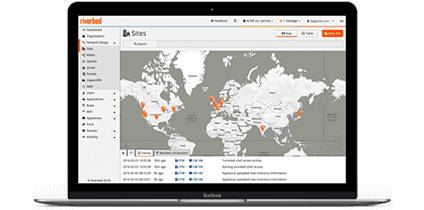Rethinking the network for digital transformation
Sponsored content written & produced by Studio 61 of CBS Interactive’s marketing unit in collaboration with the sponsor, Riverbed.
Published on 3/20/2018
Rethinking the network for digital transformation
Sponsored content written & produced by Studio 61 of CBS Interactive’s marketing unit in collaboration with the sponsor, Riverbed.
said it was CEO, CMO, CFO or another non-IT C-level executive.
said that a VP, a business leader or an IT director was leading the digital transformation.
said that it was someone other than the categories of individuals already mentioned.
Inability to experiment quickly.
Legacy systems.
Inability to work across silos.
Inadequate collaboration between IT and lines of business.
Risk-averse culture.




This need for greater agility and control to manage environments and embrace digital transformation more effectively has produced evolutionary advances. One such example is software-defined networking (SDN), which offers the next step in network traffic control. This is where software and policies are used to define consistent network behaviour and responses -- rather than relying on a conglomeration of individual hardware devices, each with their own configuration.
As network traffic continues to increase -- caused by the growth of the sheer number of apps we all depend on, together with the universal use of bandwidth-intensive applications such as video and real-time collaboration -- the demand for bandwidth continues to increase at a high rate. For cheaper capacity, enterprises have added internet broadband links to their existing MPLS networks. According to IDC, 40-60 percent of enterprise data traffic is migrating from private WANs to the internet.
What IT decision makers would sacrifice if it meant their teams no longer needed to spend as much time to get the network to perform at an adequate level:

of all respondents would endure a longer commute to work!

would take shorter breaks.

would handwrite all of their email correspondence.

would stop drinking coffee.

would give up their office.
More Efficient Bandwidth Utilization
Increased Productivity
Greater Opportunities for Expansion
Increased
Revenue
Greater
Agility
More Successful Digital Initiatives
Better Cloud App Performance



Partly, that was because we would have needed a partner to do the last mile, Bruce explained.
That's when OpenEye started looking into software-defined networking (SDN).
SDN seemed much more appealing in that we could buy a smaller amount of hardware, he said.
Also, the SDN approach would be the obvious way to allow us to scale up quickly.
Bruce said OpenEye settled on Riverbed® SteelConnect™ for Amazon Web Services because the product's tight integration with AWS was very appealing. It let OpenEye connect multiple accounts very easily because SteelConnect™ has a full understanding of its network topology.


Cloud Company

SteelConnect™

New Network Connections


Elizabeth Harper, CIO at GHD, said that ensuring all GHD's people -- regardless of location -- can do their jobs every day and have the tools they need to be successful is absolutely critical.
"Riverbed enabled us to create a network environment for GHD that truly performs and helps us meet client expectations," she said. "Not only does this simplify sharing and collaboration, but we anticipate saving around 75 percent of our global telecommunications costs over the medium term."
According to Harper, SteelConnect™ allows GHD to preconfigure a device using a cloud portal before delivering it to the physical site.
"This means that a non-IT person at the small office can follow simple instructions, plug the device in, and have everything up and running in minutes instead of days," she said.

Rapid Deployment of Branch Networking

Riverbed
SteelConnect™

Global
Collaboration
Taming the chaos of IT requires a new approach to networking, so networks can provide seamless access to digital services for end-users. No matter what type of organisation you are, with IT more distributed, hybrid, and dynamic than ever, hardware-bound legacy networks won't be able to meet those challenges.
Achieving each of these goals requires both a complete rethink of networking as well as a large number of technical innovations, capabilities, and integrations to transform the complex into the simple, the manual into the automated, and the fragmented into a unified whole. SD-WAN provides organisations with the ability to use business policies to automate and orchestrate all the components of digital access across a global, unified network.

Lack of Visibility and Poor App Performance

Poor Application Performance

High Hardware Costs and Insufficient Bandwidth

Manual Network Configurability

Inconsistent
Security

Network
Complexity
The need for SD-WAN is irrefutable - but the deluge of information, could lead you down the wrong rabbit-hole.
Watch a special four-part video series, produced jointly by SiliconANGLE and Riverbed, on how SD-WAN offers a way to design, deploy, and manage distributed networks for the digital enterprise.